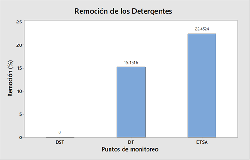Effectiveness of a filter in the removal of detergents from urban wastewater in Cajamarca, Peru
DOI:
https://doi.org/10.51252/reacae.v2i2.511Keywords:
environmental remediation, anionic detergent, filter, dumpingAbstract
The purpose of this research study was to evaluate the effectiveness of the gravel filter, aluminum sulfate and activated carbon in the elimination of detergents from urban wastewater in the city of Cajamarca. Methods: The characterization of urban residual water and the monitoring for the following parameters were carried out: detergents (SAAM), pH and turbidity. The sample was obtained from an industrial washing machine. Results: The gravel filter, aluminum sulfate and activated carbon, is effective in removing detergents from urban wastewater in the city of Cajamarca; since, 22.55% of the detergents and 98.51% of the turbidity were eliminated. Conclusions: Finally, the removal of detergents through the coagulant and a gravel and carbon filter was demonstrated.
Downloads
References
Abdelmoez, W., Barakat, N. A. M., & Moaz, A. (2013). Treatment of wastewater contaminated with detergents and mineral oils using effective and scalable technology. Water Science and Technology, 68(5), 974–981. https://doi.org/10.2166/wst.2013.275
Azizullah, A., Khan, S., Rehman, S., Taimur, N., & Häder, D.-P. (2021). Detergents Pollution in Freshwater Ecosystems. In Anthropogenic Pollution of Aquatic Ecosystems (pp. 245–270). Springer International Publishing. https://doi.org/10.1007/978-3-030-75602-4_12
Barambu, N. U., Peter, D., Yusoff, M. H. M., Bilad, M. R., Shamsuddin, N., Marbelia, L., Nordin, N. A. H., & Jaafar, J. (2020). Detergent and Water Recovery from Laundry Wastewater Using Tilted Panel Membrane Filtration System. Membranes, 10(10), 260. https://doi.org/10.3390/membranes10100260
Chen, X., Wang, Y., Bai, Z., Ma, L., Strokal, M., Kroeze, C., Chen, X., Zhang, F., & Shi, X. (2022). Mitigating phosphorus pollution from detergents in the surface waters of China. Science of The Total Environment, 804, 150125. https://doi.org/10.1016/j.scitotenv.2021.150125
Cheng, W.-H. (2009). Using a biological aerated filter to treat mixed water-borne volatile organic compounds and assessing its emissions. Journal of Environmental Sciences, 21(11), 1497–1502. https://doi.org/10.1016/S1001-0742(08)62446-8
Goel, G., & Kaur, S. (2012). A Study on Chemical Contamination of Water Due to Household Laundry Detergents. Journal of Human Ecology, 38(1), 65–69. https://doi.org/10.1080/09709274.2012.11906475
Haderiah, H., Sulasmi, S., & Erlani, E. (2015). Effectiveness of Simple Screening Media of Activated Chorcoal and Zeolite to Reduce Waste Water Levels in Laundry Detergent. International Journal of Sciences: Basic and Applied Research (IJSBAR), 24(3), 180–186. https://gssrr.org/index.php/JournalOfBasicAndApplied/article/view/4676
Jahan, K. (2004). Detergents. In Water Encyclopedia (pp. 669–674). Wiley. https://doi.org/10.1002/047147844X.ww66
Liu, Y., & Chen, J. (2014). Phosphorus Cycle. In Encyclopedia of Ecology (pp. 181–191). Elsevier. https://doi.org/10.1016/B978-0-12-409548-9.09043-6
Mclntyre, A., & He, X. (2019). Global Marine Pollution—A Brief History. In Encyclopedia of Ocean Sciences (pp. 231–235). Elsevier. https://doi.org/10.1016/B978-0-12-409548-9.11429-0
Mensah, K. A., & Forster, C. F. (2003). An examination of the effects of detergents on anaerobic digestion. Bioresource Technology, 90(2), 133–138. https://doi.org/10.1016/S0960-8524(03)00126-3
Mousavi, S. A., & Khodadoost, F. (2019). Effects of detergents on natural ecosystems and wastewater treatment processes: a review. Environmental Science and Pollution Research, 26(26), 26439–26448. https://doi.org/10.1007/s11356-019-05802-x
Rojas-Herrera, R. A., Ramos-Castillo, A. S., Estrada-Medina, H., De los Santos-Briones, C., Keb-Llanes, M. A., Barrientos-Medina, R. C., Peña-Ramírez, Y. J., & O’Connor-Sánchez, A. (2015). Living with detergents: pyrosequencing-based assessment of bacterial community structures in soils subjected for decades to contamination by detergents. Annals of Microbiology, 65(3), 1313–1322. https://doi.org/10.1007/s13213-014-0969-x
Sharo, A. A., & Daradkah, B. H. (2020). Optimizing the Impact of Detergents Contamination on the Geotechnical Properties of Soils. Procedia Manufacturing, 44, 615–622. https://doi.org/10.1016/j.promfg.2020.02.248
Tsyntsarski, B., Petrova, B., Budinova, T., Petrov, N., Teodosiev, D. K., Sarbu, A., Sandu, T., Ferhat Yardim, M., & Sirkecioglu, A. (2014). Removal of detergents from water by adsorption on activated carbons obtained from various precursors. Desalination and Water Treatment, 52(16–18), 3445–3452. https://doi.org/10.1080/19443994.2013.801327
Yaseen, Z. M., Zigale, T. T., Tiyasha, D., R. K., Salih, S. Q., Awasthi, S., Tung, T. M., Al-Ansari, N., & Bhagat, S. K. (2019). Laundry wastewater treatment using a combination of sand filter, bio-char and teff straw media. Scientific Reports, 9(1), 18709. https://doi.org/10.1038/s41598-019-54888-3

Published
How to Cite
Issue
Section
License
Copyright (c) 2023 Persi Vera-Zelada , Luis Alberto Vera-Zelada, Elvis Humberto Saucedo-Osorio, Leily Bettsy Mamani-Arias

This work is licensed under a Creative Commons Attribution 4.0 International License.
The authors retain their rights:
a. The authors retain their trademark and patent rights, as well as any process or procedure described in the article.
b. The authors retain the right to share, copy, distribute, execute and publicly communicate the article published in the Revista Amazónica de Ciencias Ambientales y Ecológicas (REACAE) (for example, place it in an institutional repository or publish it in a book), with an acknowledgment of its initial publication in the REACAE.
c. Authors retain the right to make a subsequent publication of their work, to use the article or any part of it (for example: a compilation of their works, notes for conferences, thesis, or for a book), provided that they indicate the source of publication (authors of the work, journal, volume, number and date).



